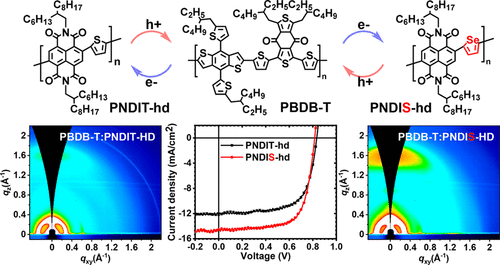当前位置:
X-MOL 学术
›
ACS Appl. Polym. Mater.
›
论文详情
Our official English website, www.x-mol.net, welcomes your feedback! (Note: you will need to create a separate account there.)
Comparative Study of Selenophene- and Thiophene-Containing n-Type Semiconducting Polymers for High Performance All-Polymer Solar Cells
ACS Applied Polymer Materials ( IF 5 ) Pub Date : 2020-09-17 , DOI: 10.1021/acsapm.0c00772 Xiaomei Ding 1 , Duyen K. Tran 1 , Daiki Kuzuhara 2 , Tomoyuki Koganezawa 3 , Samson A. Jenekhe 1
ACS Applied Polymer Materials ( IF 5 ) Pub Date : 2020-09-17 , DOI: 10.1021/acsapm.0c00772 Xiaomei Ding 1 , Duyen K. Tran 1 , Daiki Kuzuhara 2 , Tomoyuki Koganezawa 3 , Samson A. Jenekhe 1
Affiliation

|
Effects of the donor moiety substitution on the intrinsic and photovoltaic blend properties of n-type semiconducting naphthalene diimide-arylene copolymers with donor–acceptor structure were investigated. The alternating naphthalene diimide-thiophene copolymer, PNDIT-hd, and naphthalene diimide-selenophene copolymer, PNDIS-hd, were found to have identical electrochemically derived electronic structures and similar bulk electron mobility; however, PNDIS-hd has an optical bandgap of 1.70 eV, which is 0.07 eV narrower relative to that of PNDIT-hd. All-polymer solar cells incorporating the donor polymer, PBDB-T, and PNDIS-hd were found to combine a high power conversion efficiency of 8.4% with high external quantum efficiency (86%) and a high fill factor of 0.71, which are significantly enhanced compared to the corresponding PBDB-T:PNDIT-hd devices with 6.7% power conversion efficiency and 73% external quantum efficiency. The improved photovoltaic properties of the selenophene-containing acceptor copolymer relative to the thiophene counterpart originate from enhanced light harvesting, more favorable molecular packing in blends, and reduced charge recombination losses in devices. These findings demonstrate that selenophene substitution for thiophene in donor–acceptor copolymers is an effective strategy that enhances the intrinsic polymer properties as well as the performance of all-polymer solar cells incorporating them.
中文翻译:

高性能全聚合物太阳能电池含硒吩和噻吩的n型半导体聚合物的比较研究
研究了供体部分取代对具有供体-受体结构的n型半导体萘二酰亚胺-亚芳基共聚物的本征和光伏共混性能的影响。发现交替的萘二酰亚胺-噻吩共聚物PNDIT-hd和萘二酰亚胺-硒苯共聚物PNDIS-hd具有相同的电化学衍生电子结构和相似的体电子迁移率;但是,PNDIS-hd的光带隙为1.70 eV,比PNDIT-hd的光带隙窄0.07 eV。发现结合了供体聚合物,PBDB-T和PNDIS-hd的全聚合物太阳能电池具有8.4%的高功率转换效率和高的外部量子效率(86%)以及0.71的高填充因子,这是非常明显的与相应的PBDB-T相比增强了:PNDIT-hd器件具有6.7%的功率转换效率和73%的外部量子效率。相对于噻吩对应物,含硒基的受体共聚物的改进的光伏性质源自增强的光收集,在共混物中更有利的分子堆积以及在装置中减少的电荷重组损失。这些发现表明,在供体-受体共聚物中硒基取代噻吩是一种有效的策略,可以提高聚合物的固有特性以及掺入它们的全聚合物太阳能电池的性能。混合物中分子填充更有利,并减少了器件中的电荷重组损失。这些发现表明,在供体-受体共聚物中硒基取代噻吩是一种有效的策略,可以提高聚合物的固有特性以及掺入它们的全聚合物太阳能电池的性能。混合物中分子填充更有利,并减少了器件中的电荷重组损失。这些发现表明,在供体-受体共聚物中硒基取代噻吩是一种有效的策略,可以提高聚合物的固有特性以及掺入它们的全聚合物太阳能电池的性能。
更新日期:2020-09-17
中文翻译:

高性能全聚合物太阳能电池含硒吩和噻吩的n型半导体聚合物的比较研究
研究了供体部分取代对具有供体-受体结构的n型半导体萘二酰亚胺-亚芳基共聚物的本征和光伏共混性能的影响。发现交替的萘二酰亚胺-噻吩共聚物PNDIT-hd和萘二酰亚胺-硒苯共聚物PNDIS-hd具有相同的电化学衍生电子结构和相似的体电子迁移率;但是,PNDIS-hd的光带隙为1.70 eV,比PNDIT-hd的光带隙窄0.07 eV。发现结合了供体聚合物,PBDB-T和PNDIS-hd的全聚合物太阳能电池具有8.4%的高功率转换效率和高的外部量子效率(86%)以及0.71的高填充因子,这是非常明显的与相应的PBDB-T相比增强了:PNDIT-hd器件具有6.7%的功率转换效率和73%的外部量子效率。相对于噻吩对应物,含硒基的受体共聚物的改进的光伏性质源自增强的光收集,在共混物中更有利的分子堆积以及在装置中减少的电荷重组损失。这些发现表明,在供体-受体共聚物中硒基取代噻吩是一种有效的策略,可以提高聚合物的固有特性以及掺入它们的全聚合物太阳能电池的性能。混合物中分子填充更有利,并减少了器件中的电荷重组损失。这些发现表明,在供体-受体共聚物中硒基取代噻吩是一种有效的策略,可以提高聚合物的固有特性以及掺入它们的全聚合物太阳能电池的性能。混合物中分子填充更有利,并减少了器件中的电荷重组损失。这些发现表明,在供体-受体共聚物中硒基取代噻吩是一种有效的策略,可以提高聚合物的固有特性以及掺入它们的全聚合物太阳能电池的性能。



























 京公网安备 11010802027423号
京公网安备 11010802027423号